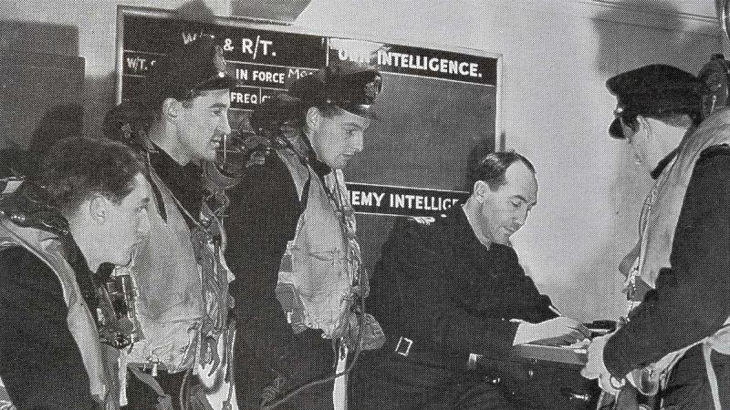A legacy to remember

Admiral Sir Victor Alfred Trumper ‘VAT’ Smith led the first mass torpedo strike against a major warship at sea, survived being shot down twice and escaped from two sinking ships.
CAPTION: Admiral Victor Smith, seated, as air operations officer on board HMS Tracker operating in the Atlantic and Arctic in 1943. Story by Corporal Luke Bellman. Photos courtesy Fleet Air Arm Association of Australia.
However, these accomplishments were not what later earned him the title of the ‘Father of Australia’s Fleet Air Arm’.
That tale has been told in a book launched by the Fleet Air Arm (FAA) Museum in late August. Admiral V.A.T. Smith: The Extraordinary Life of the Father of Australia’s Fleet Air Arm is authored by Graeme Lunn, who served as a reserve naval diver and FAA pilot in the Royal Australian Navy (RAN) before a long career with British Airways.
Mr Lunn’s experience and passion for naval aviation history led him to write the biography, which tells the story of Victor Smith, who, in 1927, at the age of 13, joined the Royal Australian Naval College (RANC) as a cadet.
He graduated as a midshipman in 1931 and went to sea in the heavy cruiser HMAS Canberra I, aged 17.
While training with the Royal Navy in the early carrier HMS Glorious, attached to the Mediterranean Fleet, he became convinced aircraft would be increasingly important.
Promoted to sub-lieutenant in 1934, Admiral Smith returned home and became a lieutenant two years later.
At that time only Air Force provided catapult aircraft and pilots to the RAN. Prevented from pilot training, he began his flying career as an observer, training in Britain to operate Shark and Swordfish torpedo bombers.
When World War 2 broke out, Admiral Smith embarked with his squadron on HMS Ark Royal to search the South Atlantic for German pocket battleship Graf Spee.
When the Germans invaded Norway, his squadron was disembarked to a naval air station in the Orkney Islands.
From there, Admiral Smith led an unescorted daylight strike at maximum range against the battlecruiser Scharnhorst and its screen of seven warships.
Only four of the six Swordfish returned from the unsuccessful low-level attack. Called a ‘gallant failure’, it was the historic first mass torpedo attack against a capital ship at sea.
Not long after, Admiral Smith became the senior observer of a Fulmar two-seat fighter squadron protecting the vital Malta convoys against long-range bombers.
Twice shot down, he saved the life of his pilot by keeping him afloat until they were rescued. He was later awarded the Distinguished Service Cross.
Returning to Australia, he was Canberra’s Walrus observer at the Battle of Savo Island in 1942, where every member of his embarked RAAF flight was killed or wounded when the cruiser sank. Admiral Smith was then posted to the escort carrier HMS Tracker.
As the air staff officer, he was responsible for tasking and briefing the aircrew protecting Atlantic and Arctic Russian convoys from U-boats and Luftwaffe bombers.
In 1944, he was promoted to lieutenant commander and became an air planning officer for the Normandy D-day invasion.
Serving ashore in the British assault area of Juno beach, Admiral Smith liaised with the Second Allied Tactical Air Force and witnessed a tank battle.
Observing air power in this campaign shaped his vision of cooperation between the three services.
In Australia, Admiral Smith helped establish the British Pacific Fleet’s air stations for the final campaign against Japan.
There he saw clearly that a Navy needed to fully control its own air power to maintain the most effective force.
When a post-war RAN FAA was proposed, Admiral Smith returned to London in 1945 to commence its planning.
In 1946, now working within an air planning staff in Melbourne’s Navy office, a two-carrier force was proposed and approved in June 1947.
Upon promotion to commander and another posting to London to liaise with the Royal Navy, Admiral Smith used their training resources for the newly forming RAN FAA.
Returning to sea, Admiral Smith was Executive Officer of the RAN’s first aircraft carrier, HMAS Sydney III, which saw action in the Korean War in 1951-52.
He was promoted to captain in 1953 and commanded four different warships and shore establishments over the next six years.
Admiral Smith attended the Imperial Defence College, London, in 1960, before taking command of the RAN’s second aircraft carrier HMAS Melbourne II.
Two years later he was promoted to rear admiral, where he continued with appointments on the naval board.
Eventually commanding the Australian fleet, his flagship escorted Australian troops to Vietnam in 1966.
In April 1968, he was promoted to vice admiral and appointed Chief of Navy.
He saw “the fundamental problem” facing him in this position as being how to maintain the security of the country and meet the commitments overseas into which the government had entered.
When Admiral Smith finished as Chief of Navy, there were 53 ships in service, the largest RAN fleet since 1945.
Admiral Smith was promoted to admiral in 1970 and for five years was Chairman of Chiefs of Staff Committee – now known as the Chief of the Defence Force.
The first RANC graduate to achieve 4-star rank, Admiral Smith retired after almost 49 years of service. He died on July 10, 1998, aged 85.
Admiral V.A.T. Smith: The Extraordinary Life of the Father of Australia’s Fleet Air Arm is published by Avonmore Books. All royalties will go to the FAA Association of Australia for charitable causes.
CAPTION: A portrait of a young Admiral Victor Smith.
.
.

.
.






